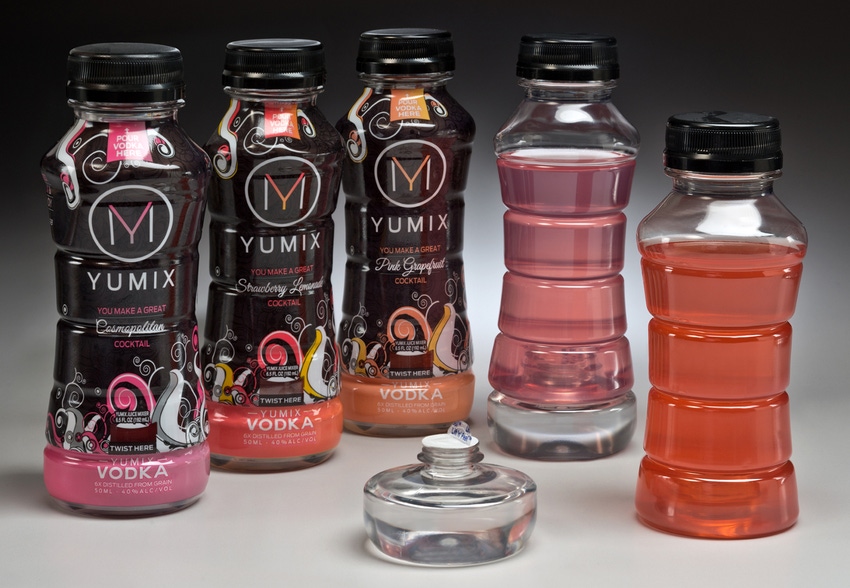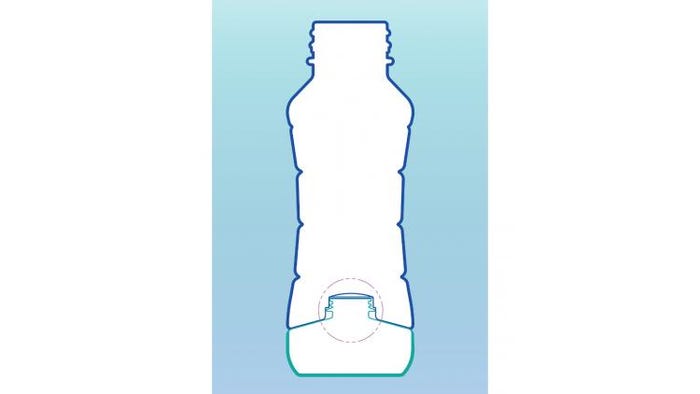Two-part container disrupts ready-to-drink cocktail category
October 3, 2016

Cocktail shelves are more crowded every day, with new products continually entering the fray. Brand owner Yumix aims to cut through the noise with stand-out, two-part packaging designed to grab and engage consumers.
Specially engineered for Yumix by Plastic Technologies Inc. (PTI), the Clasper bottle comprises two PET compartments that snap together. The bottom contains 50 mL of alcohol, with a heat-applied aluminum-foil seal. The upper component holds 6.5 oz. of hot-filled, shelf-stable juice topped by a 38-mm PPE closure. A decorative shrink-sleeve label covers the two, adorning the beverage packaging with eye-catching graphics and instructions on how to separate the containers, mix the liquids and enjoy.
From the beginning, Yumix founder Alex Garner set his sights on a multi-component container for the cocktails. With a decade of experience working in sales for consumer packaged goods (CPG) giants ConAgra Foods and Coca-Cola, he came up with the mix-it-yourself cocktail concept, but he was well aware achieving the right product quality and packaging performance would be tricky.
“I knew from my experience that if we tried to premix the juice and alcohol, the enzymes in the juice would quickly alter the taste,” Garner says. “You would then have to add preservatives and sweetener, which would alter the flavor profile. That’s not what we wanted to do and that’s why we expended significant effort to develop the right package. The end result has been driven by our quality goals.”
Garner engaged PTI to turn the product concept into reality via innovative packaging design.
“Alex challenged us to create a bottle for Yumix that would be commercially viable and function in the intended way,” says Tracy Momany, vp, PTI’s product development group. “It was a matter of designing the bottle so that it delivered both aesthetics and performance. The most technically challenging part was getting the components to snap together and stay together—further complicated by the 185-deg F. hot-fill requirements.”

The design team faced a number of unique challenges. The upper bottle is prone to deformation during hot fill. Adding to that, the larger than typical headspace is needed to allow for the consumer’s addition of the alcohol prior to consumption; this space increases the vacuum in the package significantly, putting stress on the bottle.
The trick: achieving the precise geometry and packaging weight required to keep dimensions within the appropriate tolerances and achieve a consistent snap fit, while making it easy for consumers to separate the two compartments. After a two-year development process, PTI came up with a structure using ribs (rather than vacuum panels) to reach the right balance between structure and aesthetics.
“Creating the bottom alcohol-container container also was challenging because it is so short and wide relative to the size of the 20-mm finish. A tiny preform had to be developed from which to blow the bottle,” Momany explains.
Yumix works with a contract packaging firm to produce and fill the bottle. According to Garner, the end result succeeds by giving consumers beverage packaging with appealing aesthetics (created by Las Vegas-based designer Jera Mehrdad), and flexibility in use.
“Although the package is shelf stable, most will choose to refrigerate it before consuming for a refreshing experience. It also gives consumers the added safety of being able to mix their own drink, without guessing at the alcohol content. This helps support responsible drinking,” he says.
Yumix launched retail distribution in Texas September 2016 with strawberry lemonade, cosmopolitan and pink grapefruit varieties, each paired with vodka. Depending on the variety, shelf life reaches up to 18 months, without refrigeration. Garner plans to add flavors in the coming months and expand to national distribution in 2017

Former Packaging Digest senior editor Jenni Spinner is a trade journalist with two decades of experience in the field. While she has covered numerous industries (including construction, engineering, building security, food production and public works), packaging remains her favorite.
About the Author(s)
You May Also Like


